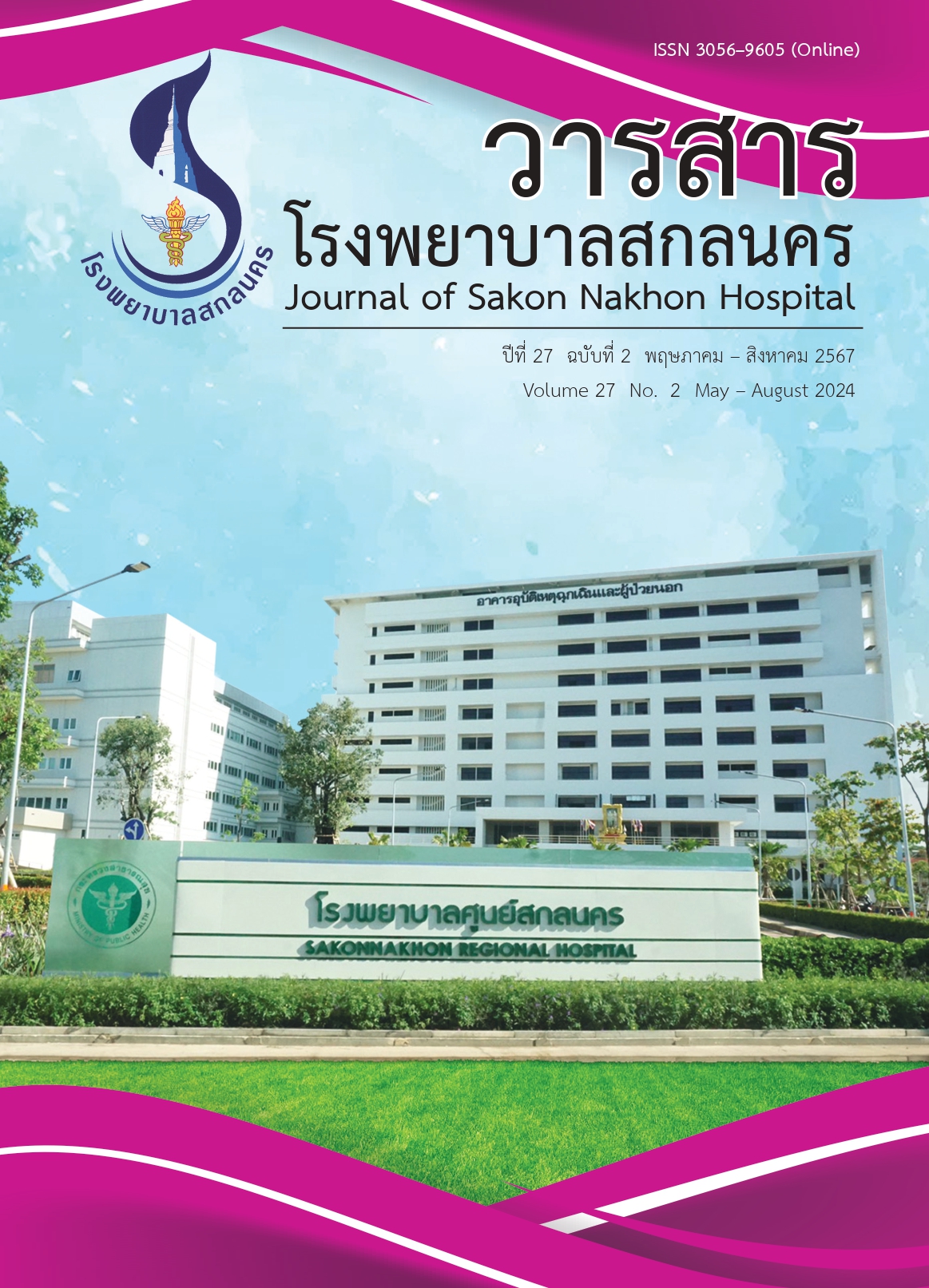The Effects of Practice Program to Prevent Delirium in Patient with Surgical Critical Care
Keywords:
Delirium, Surgical critical care, Prevention, Practice programAbstract
This quasi-experimental research aimed to study the effects of practice program to prevent delirium in patient with surgical critical care. The samples groups recruited by purposive sampling consisted were 1) 14 registered nurses worked in surgical intensive care unit 2 and 2) 30 patients with surgical critical care admitted in surgical intensive care unit 2. The research instruments included 1) practice program to prevent delirium in patient with surgical critical care 2) registered nurse’s data collection form, the evaluation questionnaire for knowledge and practice behavior and satisfaction assessment to the practice program and 3) patient ‘s data collection form. The content validity of all instruments analyzed by the index of item-objective congruence were 0.85 to 1. Data was analyzed by using the descriptive statistics: percentage, mean and standard deviation. The different comparison was analyzed by the Wilcoxon sign-rank test.
The results of the research found that after participation in the practice program to prevent delirium in patient with surgical critical care 1) the mean scores of knowledge and behavior in practicing to prevent delirium of nurse participants were 16.43 (SD = 2.28) and 68.14 (SD = 2.18), respectively, which was significantly higher than before receiving the program at the 0.05 level 2) the incidence of delirium in patients with surgical critical care after program implementation was not occurred and 3) the overall nurses' s satisfaction with the practice program was at high level (Mean = 4.15, SD = 0.61). Therefore, this program should be further applied in practice to prevent delirium in other critical care wards with similar characteristics of patients.
References
Cavallazzi R, Saad M, Marik PE. Delirium in the ICU: An overview. Ann of Intens Care 2012;2: 49.
Icudelirium.org. Nashville: Critical Illness, Brain dysfunction, and Survivorship (CIBS) Center [Internet]. 2018 [cited 2024 Feb 6]. Available from: http//www.icudelirium.org
ลีต้า อาษาวิเศษ, มยุรี ลี่ทองอิน, สิริมาศ ปิยะวัฒนพงศ์. ความรู้ ทัศนคติ และการปฏิบัติของพยาบาลต่อภาวะสับสนเฉียบพลันหลังผ่าตัดในผู้สูงอายุ โรงพยาบาลตติยภูมิแห่งหนึ่ง จังหวัดอุบลราชธานี. ว.การพยาบาลและการดูแลสุขภาพ 2562;37:235-43.
สิริมาศ ปิยะวัฒนพงศ์, มยุรี ลี่ทองอิน, สุภาวดี เที่ยงธรรม, สาวิตรี สมมงคล, ธารินี เพชรรัตน์, ศจีมาศ แก้โคตร. ความสัมพันธ์ระหว่างความรู้ ทัศนคติ กับพฤติกรรมการพยาบาลของพยาบาลในการดูแลภาวะสับสนเฉียบพลันหลังผ่าตัดในผู้สูงอายุ. ศรีนครินทร์เวชสาร 2562;34(3):281-5.
Rood PJT, Zegers M, Ramnarain D, Koopmans M, Klarenbeek T, Ewalds E, et al. The Impact of Nursing Delirium Preventive Interventions in the ICU: A Multicenter Cluster-randomized Controlled Clinical Trial. Am J Respir Crit Care Med 2021;204(6):682-91.
พรสุดา งามแสง, มยุลี สำราญญาติ, จิราภรณ์ เตชะอุดมเดช, กวีศักดิ์ จิตตวัฒนรัตน์. ประสิทธิผลของการใช้แนวปฏิบัติทางคลินิกสำหรับการป้องกันและการจัดการภาวะสับสนเฉียบพลันในผู้ป่วยวิกฤต. พยาบาลสาร มหาวิทยาลัยเชียงใหม่ 2566;50(4):56-76.
กัญจนา ปุกคำ, กุสุมา คุววัฒนสัมฤทธิ์, ธารทิพย์ วิเศษธาร. การประเมินความเป็นไปได้และผลลัพธ์ทางคลินิกของการใช้โปรแกรมการประเมินการป้องกันและการจัดการภาวะสับสนเฉียบพลันในหอผู้สูงอายุวิกฤตศัลยกรรม. ว. การปฏิบัติการพยาบาลและการผดุงครรภ์ไทย 2562;6(1):68-86.
สุนันทา ครองยุทธ. การจัดการภาวะสับสนเฉียบพลันของผู้ป่วยไอ ซี ยู. ว. คณะพยาบาลศาสตร์มหาวิทยาลัยบูรพา 2558;23(4):1-13.
Salluh JIF, Wang H, Schneider EB, Nagaraja N, Yenokyan G, Damluji A, et al. Outcome of delirium in critically ill patients: systematic review and meta-analysis. BMJ 2015;350:h2538.
ปรียาวดี เทพมุสิก, ศศิธร ชำนาญผล, นิตยา กรายทอง, สุกัญญา ผลวิสุทธิ์,จันทนา นิลาศน์, จรูญศรี มีหนองหว้า. ความรู้เกี่ยวกับภาวะสับสนเฉียบพลันการเฝ้าระวังและการจัดการภาวะสับสนเฉียบพลันในผู้ป่วยผู้ใหญ่วิกฤตของพยาบาลวิชาชีพงานห้องผู้ป่วยหนักโรงพยาบาลสรรพสิทธิประสงค์. ว. วิทยา ศาสตร์สุขภาพ วิทยาลัยพยาบาลบรมราชชนนี สรรพสิทธิประสงค์ 2560;1(2):70-85.
Krewulak KD, Stelfox HT, Leigh JP, Ely EW, Fiest KM. Incidence and Prevalence of Delirium Subtypes in an Adult ICU: A Systematic Review and Meta-Analysis. Crit Care Med 2018; 46(12):2029 -35.
Pipanmekaporn T, Chittawatanarat K, Chaiwat O, Thawitsri T, Wacharasint P, Kongsayreepong S, et al. Incidence and risk factors of delirium in multi-center Thai surgical intensive care units a prospective cohort study. Journal of intensive care 2015;3:53.
Brummel NE, Vasilevskied EE, Han JH, Boehm L, Pun BT, Ely EW. Implementing Delirium Screening in the ICU: Secrets to Success. CCM 2013;41(9):2196-208.
อรัญญา ศรีหาวงษ์. การพัฒนาแนวปฏิบัติการพยาบาลในการป้องกันภาวะสับสนเฉียบพลันของผู้ป่วยวิกฤต โรงพยาบาลเพ็ญ จังหวัดอุดรธานี. ว. อนามัยสิ่งแวดล้อมและสุขภาพชุมชน 2567;9(2):118-126.
Rizk P, Morris W, Oladeji P, Huo M. Review of Postoperative Delirium in Geriatric Patients Undergoing Hip Surgery. Geriatric orthopaedic surgery & rehabilitation 2016;7(2):100-5.
ณภัทร ธิคม, อรอุมา ชัยวัฒน์, กวีศักดิ์ จิตตวัฒนรัตน์. ภาวะสับสนเฉียบพลันใน ผู้ป่วยหนักทางศัลยกรรม. เวชบันทึกศิริราช 2562;12(3):196-201.
Gusmao-Flores D, Salluh J, Chalhub R, Quarantini L. The confusion assessment method for the intensive care unit (CAM-ICU) and intensive care delirium screening checklist (ICDSC) for the diagnosis of delirium. systematic review and meta-analysis of clinical studies. Critical Care 2012;16(4):115.
Christensen M. An Exploratory Study of Staff Nurses’ Knowledge of Delirium in the Medical ICU: An Asian perspective. Intensive Crit Care Nurs 2014;30(1):54-60.
Andrews L, Silva SG, Kaplan S, Zimbro K. Delirium Monitoring and Patient Outcomes in a General Intensive Care Unit. Am J Crit Care 2015;24(1):48-56.
ยิจิง ลี่, อัจฉรา สุคนธสรรพ์, สุภารัตน์ วังศรีคูณ. ความรู้ ทัศนคติ และการปฏิบัติของพยาบาลเกี่ยวกับภาวะสับสนในผู้ป่วยไอซียู โรงพยาบาลระดับตติยภูมิ เมืองคุนหมิง มลฑลยูนนาน ประเทศสาธารณรัฐประชาชนจีน. พยาบาลสาร 2564;48(4):41-53.
หอผู้ป่วยหนักศัลยกรรมทั่วไป 2 โรงพยาบาลอุดรธานี. รายงานผลการวิเคราะห์ตัวชี้วัดงานหอผู้ป่วยหนักศัลยกรรมทั่วไป 2 โรงพยาบาลอุดรธานี ประจำปี 2564-2566. อุดรธานี: โรงพยาบาลอุดรธานี; 2566.
อุ้มพร มาลาศรี, สมถวิล ธุระพระ. การศึกษาปัจจัยเสียงต่อการเกิดอุบัติการณ์และพัฒนาแนวทางการดูแลภาวะสับสนเฉียบพลันในผู้ป่วยสูงอายุที่ได้รับการผ่าตัดหัวใจแบบเปิด. ว. การแพทย์โรงพยาบาลอุดรธานี 2564;29(3):470-483.
อรชุมา ชัยวัฒน์. การระงับความปวด การกล่อมประสาท และยาคลายกล้ามเนื้อในไอซียู ศัลยกรรม. ใน: กวีศักดิ์ จิตตวัฒนรัตน์. เวชบำบัดวิกฤติศัลยศาสตร์ในเวชปฏิบัติ. เชียงใหม่: ภาควิชาศัลยศาสตร์ คณะแพทย์ศาสตร์ มหาวิทยาลัยเชียงใหม่; 2560. หน้า 457- 466.
Silva PS, Fonseca MC. Unplanned endotracheal extubations in the intensive care unit: systematic review, critical appraisal and evidence-based recommendations. Anesth Analg 2012;114(5):1003-1014.
พิชญาภรณ์ ธรรมจริยกุล. ผลของโปรแกรมการสอนแนะเพื่อป้องกันภาวะสับสนฉับพลันพฤติกรรมการปฏิบัติของพยาบาลและการเกิดภาวะสับสนฉับพลันในผู้สูงอายุที่เข้ารับการรักษาในโรงพยาบาลปริญญาพยาบาลศาสตรมหาบัณฑิต [วิทยานิพนธ์]. กรุงเทพ. จุฬาลงกรณ์มหาวิทยาลัย; 2553.
ดวงรัตน์ กวีนันทชัย, จุฑารัตน์ อัครวงศ์วิศิษฏ์, และศุภวรรณ ใจบุญ. การป้องกันและการจัดการกับ ภาวะสับสนเฉียบพลัน ในผู้สูงอายุที่รับการรักษาในโรงพยาบาล. ว.เกื้อการุณย์ 2563;27(1):162-174.
สิทธิพรร์ สุนทร. แนวคิดและกระบวนทัศน์ในการกาหนดขนาดตัวอย่างด้วย G*Power. ว.สหวิทยาการวิจัย 2562;8(1):29-39.
บุญใจ ศรีสถิตย์นรากูร. ระเบียบวิธีการวิจัยทางพยาบาลศาสตร์. พิมพ์ครั้งที่ 4. กรุงเทพฯ: พิมพ์ลักษณ์ คณะพยาบาลศาสตร์ จุฬาลงกรณ์มหาวิทยาลัย; 2550.
Downloads
Published
How to Cite
Issue
Section
License
บทความที่ตีพิมพ์ถือว่าเป็นลิขสิทธิ์ของวารสารโรงพยาบาลสกลนคร การคัดลอกเพื่อพัฒนาเชิงวิชาการต้องได้รับการอ้างอิงอย่างถูกต้อง






